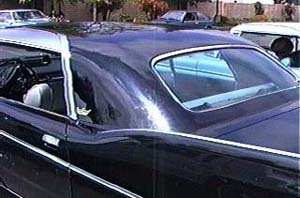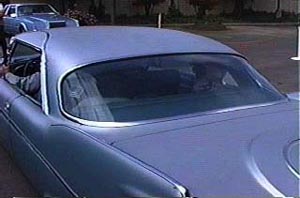-
Used POR15 on top of the frame and in the rotted out parts of the trunk trunk opening (at the bottom of the opening) that
are rusted through. The 1960-63-trunk opening had a bad design in that they
trapped and held water at their opening's bottom instead of draining it away.
This was corrected in the 1964 body change and is an interesting point to
notice in the design evolution of Imperial. I am planning to coat the
existing rust, kill it if possible, and then smear in lots of body filler
to rebuild the area where the metal has rotted away. The proper way to do
this is to cut out a good piece from a car and weld it in. The other car
has this piece and is decent (maybe the only thing that isn't rotted away!),
but I am going to take this shortcut now, and cut the other part out of the
donor car before I get rid of its stripped, rusty shell at the wreckers in
the future. If this shortcut fails, I'll still have the part and can do it
later in life when I'm not facing an entire car to finish (plus I haven't
learned to weld yet, and am trying to avoid paying for work that I can
learn to do wherever possible).
-
LeBaron rear Window leaded seam poses a unique challenge to this restoration.
The 1960 body is unique and was a good one. At manufacture, Chrysler stamped
a separate panel that fits into the rear window hole in the standard body
with a much smaller window in it that created the 1960 LeBaron, giving the
appearance of a more formal limousine and more privacy to the rear
passengers. This panel is fitted into the body and has a channel where the
two meet that did become a problem and is considered a design defect.
There is a white rope that fills the channel that I can only suppose is
asbestos, as it is impervious to my torch and very brittle in an asbestos
sort of way. This rope is affixed into the channel with nails that go
through it and into the frame. I'll assume that there were pre-drilled
holes that the nails were forced into. The asbestos rope was covered with
lead as filler. Lead was used on cars as moldable body filler before the
advent of modern plastic body fillers.

LeBaron Rear Window
|

Crown Rear Window
|
-
The problem with this arrangement is that it is a design defect. Over time
all 1960 LeBarons that I have seen all have a 1-inch wide bubbled ridge that
rises in a ¼ inch high hump where the lead seam has lifted up. After talking
with others that have the same problem, I think that the best explanation to
date came from Mark Lamp. He supposes that the bottom of the channel that
holds the rope is open to the interior of the car and may take on moisture,
swelling the rope, and consequently forcing the leaded seam to rise like a
loaf of bread.
Whatever the case, this will be quite a bit of work to repair. I have
melted most of the seam out with my handheld MAPP propane torch, and will
grind out the rope with a grinder and a respirator to avoid the dust that
will be produced.
-
Fixing the Seam: This will come in a later installment, as I have put it
on hold for now.
|

